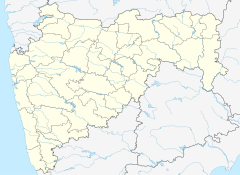
Maha Shivaratri is a Hindu festival celebrated annually in honour of the god Shiva. The name also refers to the night when Shiva performs the heavenly dance. There is a Shivaratri in every luni-solar month of the Hindu calendar, on the month's 13th night/14th day, but once a year in late winter and before the arrival of Summer, marks Maha Shivaratri which means "the Great Night of Shiva".
Śrāvaṇa is the fifth month of the Hindu calendar. In India's national civil calendar, Śrāvaṇa is the fourth month of the Hindu year, beginning in late July from the first day of the full moon and ending in the third week of August, the day of the next full moon. In the Tamil calendar, it is known as Āvani and is the fifth month of the solar year. In lunar religious calendars, Śrāvaṇa begins on the new moon and is the fourth month of the year. Srabon is the fourth month of the Bengali calendar. This is also the 2nd month of Varsha (rainy) season.
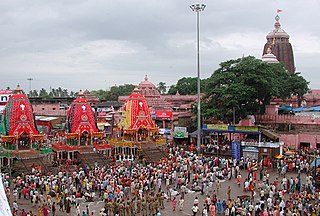
Ratha Yatra is a Hindu festival associated with Lord Jagannath held at Puri in the state of Odisha, India. It is the oldest Ratha Yatra taking place in India and the World, whose descriptions can be found in Brahma Purana, Padma Purana, and Skanda Purana and Kapila Samhita.

Gupteswar Cave is a city shrine dedicated to Shiva. It is a pilgrim site situated about 55 km (34 mi) away Jeypore, Koraput District in the state of Odisha, India. It is a limestone cave, and its main attraction is the gigantic Shiva Linga which is said to be increasing in size. Pilgrims from all over the country come here during the Sravana period because the yearly Bol Bam yatra is held at this place. Devotees walk to the Gupteshwar during Bol Bam yatra to bathe in the maha kund, and then chant near the Shiva Linga. There are 200 steps to reach to the Shiva linga temple. Its entrance is about 3 metres (9.8 ft) wide and 2 metres (6.6 ft) high.
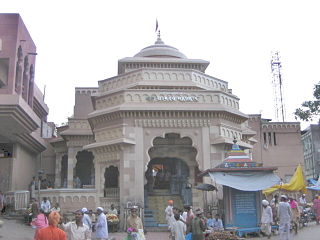
Sri Kshetra Pandharpur is a well known pilgrimage town, city on the banks of Chandrabhaga River in Solāpur district, Maharashtra, India. Pandharpur is situated on 17°11' north latitude and 75°11' east longitude in Solapur District. The Vithoba temple attracts about a million Hindu pilgrims during the major yātrā (pilgrimage) in Ashadh (June–July). A small temple of Shri. Vitthal-Rukmini is also located, which is as old as the main Vitthal-Rukmini Mandir, in Isbavi area of Pandharpur known as Wakhari Va Korti Devalayas and also known as Visava Mandir. The Bhakti Saint, Chaitanya Mahaprabhu, is said to have spent a period of 7 days in city at the Vithobha Temple. It is said that the deity Vithoba has been worshipped by many saints of Maharashtra. Sant Dnyaneshwar, Sant Tukaram, Sant Namdev, Sant Eknath, Sant Nivruttinath, Sant muktabai, Sant Chokhamela, Sant Savata Mali, Sant Narhari Sonar, Sant Gora Kumbhar and Sant Gajanan Maharaj are a few of those prominent saints.

Omkareshwar is a Hindu temple dedicated to God Shiva. It is one of the 12 revered Jyotirlinga shrines of Shiva. It is on an island called Mandhata or Shivpuri in the Narmada river at Khandwa district in Madhya Pradesh, India; the shape of the island is said to be like the Devanagari ॐ symbol.

Mahakaleshwar Jyotirlinga is a Hindu temple dedicated to Lord Shiva and is one of the twelve Jyotirlingams, shrines which are said to be the most sacred abodes of Lord Shiva. It is located in the ancient city of Ujjain in the state of Madhya Pradesh, India. The temple is situated on the side of the holy river KShipra. The presiding deity, Lord Shiva in the lingam form is believed to be Swayambhu, deriving currents of power (Shakti) from within itself as against the other images and lingams that are ritually established and invested with mantra-shakti.
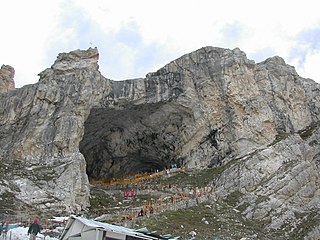
Amarnath cave is a Hindu shrine located in Jammu and Kashmir, India. The cave is situated at an altitude of 3,888 m (12,756 ft), about 141 km (88 mi) from Srinagar, the summer capital of Jammu and Kashmir and reached through Pahalgam town. The shrine forms an important part of Hinduism, and is considered to be one of the holiest shrines in Hinduism. The cave is surrounded by snowy mountains. The cave itself is covered with snow most of the year except for a short period of time in summer when it is open for pilgrims. Hundreds of thousands of Hindu and other devotees make an annual pilgrimage to the Amarnath cave across challenging mountainous terrain.
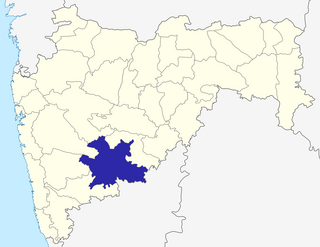
Solapur District is a district in Maharashtra state of India. The city of Solapur is the district headquarters. It is located on the south east edge of the state and lies entirely in the Bhima and Seena basins. The entire district is drained by the Bhima River.
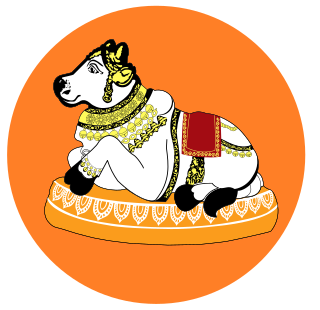
The Jangam or Jangama are a Shaiva order of religious monks. They are the priests or gurus of the Hindu Shaiva sect. Jangamas are also gurus of Veershaiva' sect. Jangamas are disciples of Lord Shiva as mentioned in Basava Puranas. A visit of a jangam to a house is treated as the visit of Lord Shiva himself and the jangam shall be given good alms and the jangam blesses the natives. The Jangam is the wandering holy man in Virashaivism. The meaning of word Jangam is 'moving linga' and considered superioir to 'sthira linga'.
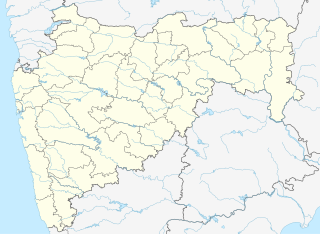
Umarga/ Omerga is a town with a municipal council in the Osmanabad district in the Indian state of Maharashtra. It is an administrative headquarter of the Umarga Tehsil.
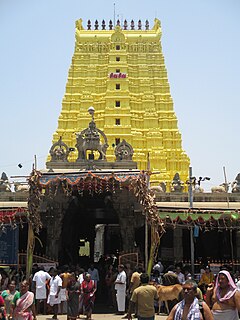
Ramanathaswamy Temple is a Hindu temple dedicated to the god Shiva located on Rameswaram island in the state of Tamil Nadu, India. It is also one of the twelve Jyotirlinga temples. It is one of the 274 Paadal Petra Sthalams, where the three of the most revered Nayanars, Appar, Sundarar and Tirugnana Sambandar, have glorified the temple with their songs. The temple was expanded during the 12th century by Pandya Dynasty, and its principal shrines sanctum were renovated by Jeyaveera Cinkaiariyan and his successor Gunaveera Cinkaiariyan of the Jaffna kingdom. The temple has the longest corridor among all Hindu temples in India. The temple is located in Rameswaram considered a holy pilgrimage site for Shaivites, Vaishnavites and Smarthas. The presiding deity, the Lingam of Ramanathaswamy (Shiva), was established and worshiped by Rama before crossing his bridge to Lanka.

Vaidyanatha Jyotirlinga temple, also known as Baba Baidyanath dham and Baidyanath dham is one of the twelve Jyotirlingas, the most sacred abodes of Shiva. It is located in Deoghar in the Santhal Parganas division of the state of Jharkhand, India. It is a temple complex consisting of the main temple of Baba Baidyanath, where the Jyotirlinga is installed, and 21 other temples.

Yātrā, in Hinduism and other Indian religions, generally means a pilgrimage to holy places such as confluences of sacred rivers, places associated with Hindu epics such as the Mahabharata and Ramayana, and other sacred pilgrimage sites. Tīrtha-yātrā refers to a pilgrimage to a holy site and is generally undertaken in groups. One who goes on a yatra is known as a yatri. As per Vedic Hindu Dharma Shastras, a Yatri is supposed to do Yatra barefoot. He/she should travel without umbrellas, vehicles etc., to get the benefit of the Yatra. At present these rules are not followed by many pilgrims.

Kartika Purnima is a Hindu, Sikh and Jain cultural festival, celebrated on the Purnima day or the fifteenth lunar day of Kartik (November–December). It is also known as Tripuri Purnima and Tripurari Purnima. It is sometimes called Deva-Diwali or Deva-Deepawali, the festival of lights of the gods. Karthika Deepam is a related festival celebrated in South India and Sri Lanka on a different date.
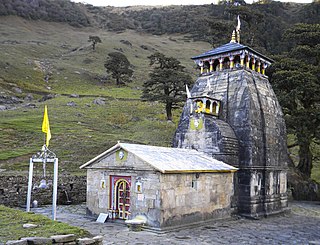
Madhyamaheshwar or Madmaheshwar is a Hindu temple dedicated to god Shiva, located in the Goundar village of Garhwal Himalayas in Uttarakhand, India. Situated at an elevation of 3,497 m (11,473.1 ft), Ukhimath is winter seat of Madmaheswar, It is the Panch Kedar pilgrimage circuit, comprising five Shiva temples in the Garhwal region. The other temples in the circuit include: Kedarnath, Tungnath and Rudranath to be visited before Madmaheshwar and Kalpeshwar to be visited after Madmaheshwar. The middle (madhya) or belly part or navel (nabhi) of the Shiva, is worshipped at this temple, believed to be built by the Pandavas, the survivors of the Hindu epic Mahabharata.

Rama Navami is a spring Hindu festival that celebrates the birthday of the Hindu God Lord Rama. He is particularly important to the Vaishnavism tradition of Hinduism, as the seventh avatar of God Vishnu. The festival celebrates the descent of Vishnu as shri Rama avatar, through his birth to King Dasharatha and Queen Kausalya in Ayodhya. The festival is a part of the spring Navratri, and falls on the ninth day of the bright half in the Hindu calendar month of Chaitra. This typically occurs in the Gregorian months of March or April every year. Rama Navami is an optional government holiday in India.

Ratha Yatra, also known Ratha Jatra or Chariot festival. It is the biggest and oldest festival celebrated on the earth. On the Rathayatra festival the Deities from the main temple of Puri, Odisha are aboded on 3 decorated chariots and pulled by millions of devotees gathered from across the world and taken to their birth temple called Gundicha Temple. Lord Jagannatha is the Lord of the Universe, also known as the Purushottama or Param Brahmh, worshipped with Lord Balabhadra, Maha Devi Subhadra and Sudarshana Chakra at the Puri Shree Jagannath Temple in Odisha. this festival is observed across the world in more than 100 countries.

The Saty Narayan Ji Temple in Nabha is a famous, sacred Hindu temple dedicated to Vishnu and located on the North of India, at Nabha in the state of Punjab.
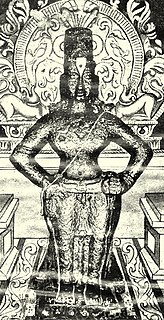
Pandharpur Wari or Wari pronounced vaaree, is an annual pilgrimage (yatra) to the town of Pandharpur, which is the seat of Hindu God Vithoba in the Indian state of Maharashtra, in honour of the deity. Palakhis carrying the paduka of the deity and various saints, most notably Dnyaneshwar and Tukaram from the Warkari sect, are taken from their respective shrines to Pandharpur. Warkari is a Marathi term which means "one who performs the Wari" or "one who venerates the Vithoba". The tradition is more than 700 to 800 years old.

